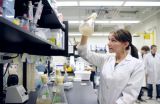(Press-News.org) One of the most vexing challenges in the battle against dengue virus, a mosquito-borne virus responsible for 50-100 million infections every year, is that getting infected once can put people at greater risk for a more severe infection down the road.
Now, for the first time, an international team of researchers that includes experts from the University of California, Berkeley, has pulled apart the mechanism behind changing dengue virus genetics and dynamics of host immunity, and they are reporting their findings in the Dec. 21 issue of Science Translational Medicine.
The virus that causes dengue disease is divided into four closely related serotypes (dengue virus 1, 2, 3 and 4), and those serotypes can be further divided into genetic variants, or subtypes.
The researchers showed that a person's prior immune response to one serotype of dengue virus could influence the interaction with virus subtypes in a subsequent infection. How that interaction plays out could mean the difference between getting a mild fever and going into a fatal circulatory failure from dengue hemorrhagic fever or dengue shock syndrome.
The findings have implications for the efforts to combat a disease that has grown dramatically in recent decades, including the development of a first-ever dengue vaccine.
According to the World Health Organization, dengue disease is now endemic in more than 100 countries around the world, and recent estimates say some 3 billion people – almost half of the world's population – are at risk.
It was already known that upon a person's first infection with dengue virus, the immune system reacts normally by creating antibodies to fight the viral invaders. The problem is that those antibodies can then be confused if confronted later with one of the other three types of dengue virus, and as this new study revealed, even different subtypes within the same serotype.
"With the second infection, the antibodies sort of recognize the new type of viruses, but not well enough to clear them from the system," said study lead author Molly OhAinle, post-doctoral fellow in infectious diseases at UC Berkeley's School of Public Health. "Instead of neutralizing the viruses, the antibodies bind to them in a way that actually helps them invade the immune system's other cells and spread."
The study authors noted that this Trojan horse effect has been shown before, but the new research provides an analysis of the interplay between viral genetics and immune response with unprecedented detail, going beyond the main serotype.
Putting the puzzle pieces together required UC Berkeley's expertise in immunology and virology, the genome analysis and biostatistical capabilities at the Broad Institute of Harvard University and Massachusetts Institute of Technology, and the epidemiological and clinical field work at Nicaragua's National Virology Laboratory.
Researchers used data from two independent, Nicaragua-based studies headed by Eva Harris, professor of infectious diseases and vaccinology and director of UC Berkeley's Center for Global Public Health, and Dr. Angel Balmaseda, director of the National Virology Laboratory in Nicaragua. One was a hospital-based study that examined children admitted to the National Pediatric Reference hospital with dengue between 2005 and 2009. The other was a prospective study that had followed 3,800 children since 2004, with blood samples collected annually.
By following dengue cases in both studies, researchers were able to identify a dramatic increase in severe dengue disease and then sequence the virus across time. They detected genetic changes in the virus that coincided with changes in disease severity, but only in the context of pre-existing immune response to specific dengue virus serotypes.
They found that children who had antibodies to dengue virus 3, which circulated in the region from 1994-1998, were at greater risk for developing severe infections when exposed to subtype 2B of dengue virus 2. They also found that children who had antibodies to dengue virus 1, which circulated from 2002-2005, were also at increased risk of severe disease from exposure to subtype 1 of dengue virus 2 after an initial period of immunity wears off.
"We showed for dengue that both the subtype of virus you get infected with and whether your body has antibodies to another type of virus matter," said Matthew Henn, director of viral genomics at the Broad Institute. "If you get the wrong combination of the two, you are more likely to get severe disease. This study provides a framework we can utilize to eventually predict which specific virus types will proliferate in different human populations. We lacked a good model for this previously."
The researchers followed up with tests in the lab to confirm the complex interplay of viral genetics and immune system response.
Harris understands this risk on a personal level. She has been studying dengue in Nicaragua for 24 years, and in 1995, became infected with dengue virus type 3. That puts her at greater risk for a severe reaction should she become exposed to other dengue virus serotypes.
While no vaccine yet exists for dengue, Harris noted that the vaccines currently under development aim to immunize against all types of the virus.
"Our findings have implications for vaccine development and implementation, as the precise genetics of vaccine strains, as well as the timing and serotype sequence of infection prior to and after vaccination, play an important role in determining the outcome of infection," she said.
Harris added that this study benefitted from decades of productive collaboration between U.S. and Nicaraguan researchers. "It was the multi-disciplinary approach we took to analyzing two high-quality studies that allowed us to untangle this very complex phenomena," she said.
###Funding from the National Institute of General Medical Sciences, the National Institute of Allergy and Infectious Diseases and the Pediatric Dengue Vaccine Initiative provided support for this research.
Study details how dengue infection hits harder the second time around
2011-12-22
ELSE PRESS RELEASES FROM THIS DATE:
Stanford engineers achieve record conductivity in strained lattice organic semiconductor
2011-12-22
Organic semiconductors could usher in an era of foldable smartphones, better high-definition television screens and clothing made of materials that can harvest energy from the sun needed to charge your iPad, but there is one serious drawback: Organic semiconductors do not conduct electricity very well.
In a paper to be published online on Wednesday by the journal Nature, researchers at Stanford led by chemical engineer Zhenan Bao have changed that equation by improving the ability of the electrons to move through organic semiconductors. The secret is in packing the molecules ...
Silver Formula CO. LTD. Announces The Release Of Swim SF Nano Treatment
2011-12-22
Silver Formula Co. Ltd. formally announces the release of its new SWIM SF system - an eco-friendly and non-abrasive substance that uses a silver-copper colloid to sanitize swimming water at the molecular level. To celebrate the launch of this cutting-edge product, Silver Formula is beginning a campaign to raise awareness of the dangers of the now-outdated chlorination method of sanitation.
Chlorine remains the most popular method for maintaining both public and private swimming pools, largely due to ignorance of both the harmful side effects of chlorine and the alternatives ...
Raxco Software Releases PerfectDisk 12.5
2011-12-22
Raxco Software, the leader in disk defrag and optimization software, announced today PerfectDisk 12.5, the latest version of its award-winning and Microsoft-certified utility. This latest version adds a new Space Management feature that helps businesses and users reclaim wasted disk space and better manage their storage, as well as peer-to-peer remote capability to more easily manage remote clients.
The new Space Management adds several capabilities, including:
· Duplicate File Finder -- recovers disk space by detecting and removing duplicate files such as text documents, ...
Taking a predictive approach to identifying adverse drug reactions
2011-12-22
Boston, Mass. – In a move aimed at bolstering current systems for assessing and monitoring drug safety, researchers at Children's Hospital Boston have created a new method that combines multiple forms of widely available data to predict adverse drug reactions. Unlike current approaches, which rely on detecting evidence of drug safety issues as they accumulate over time in clinical databases, this new method may be able to identify issues years in advance.
This study, led by Aurel Cami, PhD, and Ben Reis, PhD, of Children's Hospital Boston's Informatics Program (CHIP), ...
Holiday Giving Is An Abiding Pledge With Pardee Homes
2011-12-22
Giving back to the communities in which it builds is a Pardee Homes tradition that takes on special meaning every holiday season, and perhaps never more so than this year. "A slow economy is hardest on the less fortunate, making useful outreach especially critical," said Mike McGee, president and chief executive officer of the LA-based homebuilder. "Our employees made exceptional efforts this year and their unfailing generosity is truly gratifying."
Pardee's holiday giving campaign was born nine years ago when company employees decided they preferred ...
UNC study could lead to a treatment for Angelman syndrome
2011-12-22
VIDEO:
Angelman syndrome is a severe neurodevelopmental disorder
caused by mutation or deletion of the maternally inherited copy of Ube3a
(blackened region of the chromosomes). The paternally inherited copy of
Ube3a is intact...
Click here for more information.
CHAPEL HILL, N.C. – Results of a new study from the University of North Carolina at Chapel Hill may help pave the way to a treatment for a neurogenetic disorder often misdiagnosed as cerebral palsy or autism.
Known ...
Astronomers discover deep-fried planets
2011-12-22
Two Earth-sized planets have been discovered circling a dying star that has passed the red giant stage. Because of their close orbits, the planets must have been engulfed by their star while it swelled up to many times its original size.
This discovery, published in the science journal Nature, may shed new light on the destiny of stellar and planetary systems, including our solar system.
When our sun nears the end of its life in about 5 billion years, it will swell up to what astronomers call a red giant, an inflated star that has used up most of its fuel. So large ...
San Diego Mold Remediation Company Offers Advanced Mold Testing
2011-12-22
Orange Restoration, based in San Diego, adds legally binding mold and hazardous material lab testing to their growing list of professional services. Testing services include air, surface and swab testing, testing or lead and/or asbestos and post remediation cleanup testing.
Nearly anyone can look at a black spot on a wall or ceiling and declare, you have black mold and need to have it professionally cleaned. Few companies have the expertise to perform scientific testing to confirm both the type and quantity of the contamination being observed.
Orange Restoration's ...
Discovery of 2 Earth-size planets raises questions about the evolution of stars
2011-12-22
This press release is available in French.
University of Toulouse and University of Montreal researchers have detected two planets of sizes comparable to Earth orbiting around an old star that has just passed the red giant stage. This planetary system is located near Lyra and Cygnus constellations at a distance of 3900 light years. This discovery, to be published by in Nature on December 22 2011, may shed new light on the destiny of stellar and planetary systems.
"The two planets, named KOI 55.01 and KOI 55.02, are on very short orbits around their host star," explained ...
Researchers develop new method of cleaning toxins from the oilsands
2011-12-22
Alberta's oilsands have water challenges. Oilsands development uses a vast amount of water and even though it's recycled multiple times, the recycling concentrates the toxins and metals leftover from extracting and upgrading the bitumen, resulting in tailings ponds that are both a lightening rod for controversy and a significant risk to the environment. A research project underway between biologists at the University of Calgary and engineers at the University of Alberta to help resolve the water issue is making rapid progress toward that goal.
Two years into the research, ...


